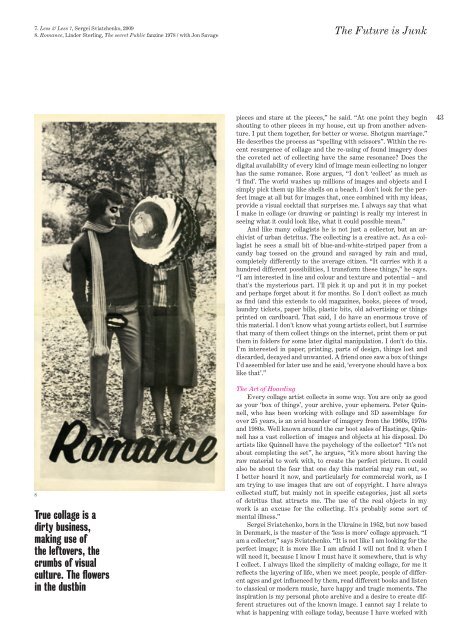THE FUTURE IS JUNK - paul burgess
THE FUTURE IS JUNK - paul burgess
THE FUTURE IS JUNK - paul burgess
Create successful ePaper yourself
Turn your PDF publications into a flip-book with our unique Google optimized e-Paper software.
7. Less 2/ Less 7, Sergei Sviatchenko, 2009<br />
8. Romance, Linder Sterling, The secret Public fanzine 1978 / with Jon Savage<br />
8<br />
<br />
<br />
<br />
<br />
<br />
<br />
<br />
The Future is Junk<br />
pieces and stare at the pieces,” he said. “At one point they begin<br />
shouting to other pieces in my house, cut up from another adventure.<br />
I put them together, for better or worse. Shotgun marriage.”<br />
He describes the process as “spelling with scissors”. Within the recent<br />
resurgence of collage and the re-using of found imagery does<br />
the coveted act of collecting have the same resonance? Does the<br />
digital availability of every kind of image mean collecting no longer<br />
has the same romance. Rose argues, “I don't ‘collect’ as much as<br />
‘I find’. The world washes up millions of images and objects and I<br />
simply pick them up like shells on a beach. I don't look for the perfect<br />
image at all but for images that, once combined with my ideas,<br />
provide a visual cocktail that surprises me. I always say that what<br />
I make in collage (or drawing or painting) is really my interest in<br />
seeing what it could look like, what it could possible mean.”<br />
And like many collagists he is not just a collector, but an archivist<br />
of urban detritus. The collecting is a creative act. As a collagist<br />
he sees a small bit of blue-and-white-striped paper from a<br />
candy bag tossed on the ground and savaged by rain and mud,<br />
completely differently to the average citizen. “It carries with it a<br />
hundred different possibilities, I transform these things,” he says.<br />
“I am interested in line and colour and texture and potential – and<br />
that's the mysterious part. I'll pick it up and put it in my pocket<br />
and perhaps forget about it for months. So I don't collect as much<br />
as find (and this extends to old magazines, books, pieces of wood,<br />
laundry tickets, paper bills, plastic bits, old advertising or things<br />
printed on cardboard. That said, I do have an enormous trove of<br />
this material. I don't know what young artists collect, but I surmise<br />
that many of them collect things on the internet, print them or put<br />
them in folders for some later digital manipulation. I don't do this.<br />
I'm interested in paper, printing, parts of design, things lost and<br />
discarded, decayed and unwanted. A friend once saw a box of things<br />
I'd assembled for later use and he said, ‘everyone should have a box<br />
like that’.”<br />
The Art of Hoarding<br />
Every collage artist collects in some way. You are only as good<br />
as your ‘box of things’, your archive, your ephemera. Peter Quinnell,<br />
who has been working with collage and 3D assemblage for<br />
over 25 years, is an avid hoarder of imagery from the 1960s, 1970s<br />
and 1980s. Well known around the car boot sales of Hastings, Quinnell<br />
has a vast collection of images and objects at his disposal. Do<br />
artists like Quinnell have the psychology of the collector? “It’s not<br />
about completing the set”, he argues, “it’s more about having the<br />
raw material to work with, to create the perfect picture. It could<br />
also be about the fear that one day this material may run out, so<br />
I better hoard it now, and particularly for commercial work, as I<br />
am trying to use images that are out of copyright. I have always<br />
collected stuff, but mainly not in specific categories, just all sorts<br />
of detritus that attracts me. The use of the real objects in my<br />
work is an excuse for the collecting. It's probably some sort of<br />
mental illness.”<br />
Sergei Sviatchenko, born in the Ukraine in 1952, but now based<br />
in Denmark, is the master of the ‘less is more’ collage approach. “I<br />
am a collector,” says Sviatchenko. “It is not like I am looking for the<br />
perfect image; it is more like I am afraid I will not find it when I<br />
will need it, because I know I must have it somewhere, that is why<br />
I collect. I always liked the simplicity of making collage, for me it<br />
reflects the layering of life, when we meet people, people of different<br />
ages and get influenced by them, read different books and listen<br />
to classical or modern music, have happy and tragic moments. The<br />
inspiration is my personal photo archive and a desire to create different<br />
structures out of the known image. I cannot say I relate to<br />
what is happening with collage today, because I have worked with<br />
43


